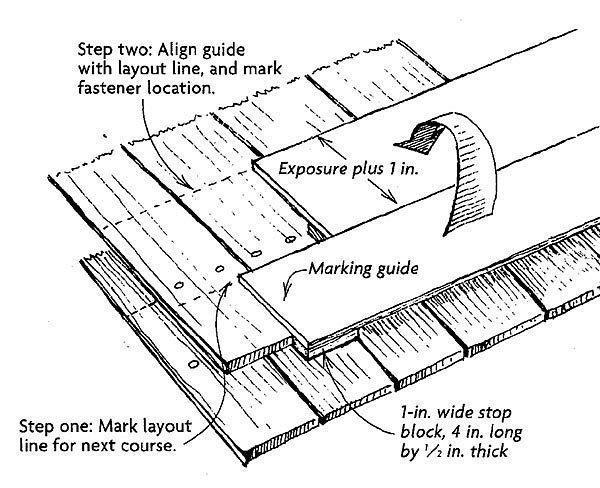Cedar-Roof Shingling Guide
Quick to make and easy to use, this plywood guide keeps courses straight and on layout.

A few years ago, I attended a seminar sponsored by a cedar-shingle manufacturer. The local rep showed a film of a real professional installing shingles. This guy was nailing so fast that the entire room burst out laughing. Like the other builders attending this event, I claim roofing as only part of my repertoire, and that level of skill just isn’t in the cards for me.
On those occasions when I do install wood shingles, I set the courses to a pencil line that I mark using a simple guide made out of a 4-ft. to 5-ft. length of 1/4-in. plywood. To make the guide, I first rip the piece of plywood to a width equal to the exposure of the shingles, plus 1 in. I affix stop blocks to the underside of the plywood at each end. As shown in the drawing, they are 1 in. wide, 4 in. long and 1/2-in. thick.
To use the guide, I position it so that the stop blocks catch the butts of the previous course of shingles. Then I draw a line along the top of the guide to locate the butts of the next course. Next, I move the guide up and lay its bottom edge along this line and mark another line along the top of the guide.
Of course, the shingles cover this line as they’re laid down, but the guide provides a reference line on the leading edge. That, and the nails in the previous shingle, are enough to eliminate any hesitation when nailing. To make sure none of the shingles wanders off layout, I snap a chalkline every few courses as a control.
— Arne Waldstein; Great Barrington, MA
From Fine Homebuilding #138
RELATED STORIES
Got a Tip?
Do you have any great tips like this guide for cedar-roof shingling? Share your methods, tricks, and jigs with other readers. Tag them @FineHomebuilding on social, email them to us at tips@finehomebuilding.com, or upload them to FineHomebuilding.com/reader-tips. We’ll pay for any we publish.
Updated November, 2024
Fine Homebuilding Recommended Products
Fine Homebuilding receives a commission for items purchased through links on this site, including Amazon Associates and other affiliate advertising programs.

Shingle Ripper

Fall Protection

Peel & Stick Underlayment






View Comments
I make a guide by ripping a piece of straight 3/4"ply the width of the exposure and tacking small blocks on the bottom edge to form a shallow T or L. It's easy to locate the guide with the blocks touching the bottom edge of the previous course. I tack the guide on with small finish nails
and can rest the shingles on the guide and nail without marking. I don't have to line up the bottom edge of the new course or have the shingles slide around. Cut a small block the exposure plus 1" and mark every few feet to guide in nailing